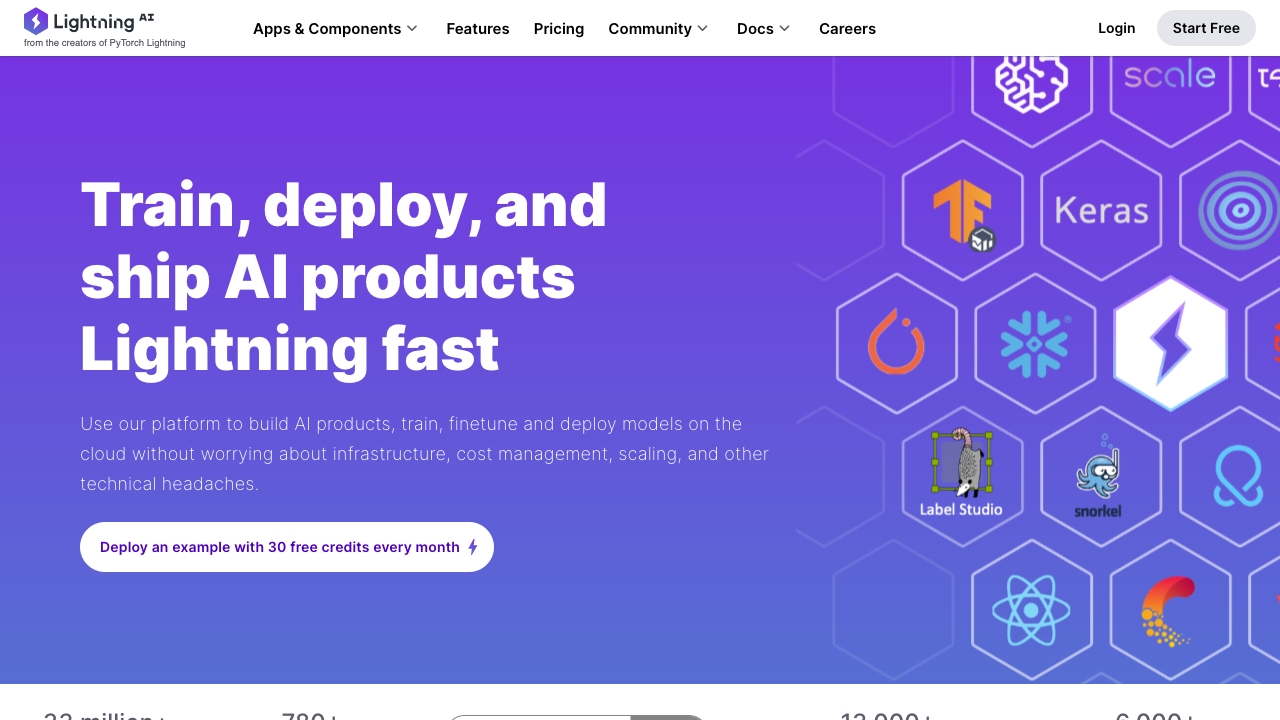- Home
- AI Text Generator
- Lightning

Lightning
Open Website-
Tool Introduction:All-in-one AI dev platform: cloud GPUs to build, train, deploy.
-
Inclusion Date:Oct 21, 2025
-
Social Media & Email:
Tool Information
What is Lightning AI
Lightning AI is an all-in-one AI development platform that lets teams build, train, scale, and serve models from the browser with zero setup. It combines cloud GPUs, collaborative DevBoxes, managed training jobs, and production-grade deployment in one workspace. From rapid prototyping to full-stack AI applications, Lightning AI streamlines data access, experiment tracking, and orchestration across GPU clusters. Developers can code together, iterate faster, and ship reliable inference endpoints without managing infrastructure.
Lightning AI Main Features
- Zero-setup DevBoxes: Spin up browser-based development environments with on-demand GPUs and reproducible setups to start coding immediately.
- Managed training: Launch and monitor training jobs, capture logs and artifacts, and scale across GPU clusters with minimal configuration.
- Model deployment: Package models as services and expose stable APIs with autoscaling and basic observability for latency and throughput.
- Collaboration: Share workspaces, invite teammates, and manage permissions to support multi-user AI development.
- Orchestration: Coordinate data prep, training, evaluation, and serving as end-to-end workflows that move smoothly from prototype to production.
- Templates and starters: Use curated examples for LLM apps, computer vision, and classic ML tasks to accelerate delivery.
- Cost awareness: Track resource usage and optimize GPU time to control spend during experiments and production.
Who Should Use Lightning AI
Lightning AI fits ML engineers, data scientists, and researchers who need fast access to cloud GPUs and a unified workflow from notebooks to production. It suits startups building full-stack AI applications, product teams shipping model-backed features, and MLOps groups standardizing training and serving. Educators and labs can use it to provide reproducible, collaborative environments without maintaining local hardware.
How to Use Lightning AI
- Create an account and open a DevBox to start a browser-based workspace.
- Select your compute profile (CPU or GPU) and choose the environment you need.
- Connect a repository and data sources; configure environment dependencies.
- Prototype in your preferred IDE or notebook, then refactor into scripts and pipelines.
- Launch managed training jobs, monitor logs and metrics, and save checkpoints.
- Package the trained model as a service and configure autoscaling and resources.
- Test the API endpoint, integrate with your application, and promote to production.
- Invite collaborators, set access controls, and track usage for ongoing optimization.
Lightning AI Industry Use Cases
- LLM applications: prototype RAG chatbots, fine-tune models, and deploy inference endpoints for product features. - Computer vision: train detectors and classifiers on cloud GPUs and serve real-time or batch inference. - Speech and media: build transcription or summarization pipelines end-to-end. - Research: run reproducible multi-GPU experiments and share results with collaborators. - Product teams: move from proof of concept to production APIs without building custom infrastructure.
Lightning AI Pricing
Pricing typically reflects usage of cloud compute and storage, with options for individual, team, and enterprise needs. Availability of free tiers or trials may change over time; review the official pricing page for current plans, GPU rates, and collaboration features.
Lightning AI Pros and Cons
Pros:
- Zero-setup environments with on-demand GPUs accelerate onboarding and iteration.
- Unified workflow for prototyping, training, and deployment reduces toolchain friction.
- Scalable training and serving simplify moving from experiments to production.
- Collaborative workspaces improve team productivity and governance.
- Cost visibility helps control GPU spending across projects.
Cons:
- Cloud dependency may not fit teams requiring fully on-premises setups.
- GPU availability and quotas can vary by region and demand.
- Potential vendor lock-in compared with self-managed infrastructure.
- Advanced customization may be limited relative to bespoke MLOps stacks.
- Data location and compliance requirements may require additional review.
Lightning AI FAQs
-
Q1: Which ML frameworks does Lightning AI support?
It supports popular Python-based workflows, allowing you to use libraries such as PyTorch and related ecosystems within its environments.
-
Q2: Can I scale training across multiple GPUs?
Yes. You can request GPU-backed compute and scale jobs to larger resources as needed for training and evaluation.
-
Q3: How do I deploy a model to production?
Package your model as a service in the platform, configure resources and autoscaling, then expose an API endpoint for integration.
-
Q4: Does it support collaboration for teams?
Teams can share workspaces, invite members, and set permissions to collaborate on code, experiments, and deployments.
-
Q5: How are costs managed?
You can monitor usage and select compute profiles to align resources with workload needs and manage spending.
-
Q6: Can I bring my own cloud or on-prem hardware?
The platform focuses on managed cloud resources. For options beyond managed compute, consult the official documentation.


